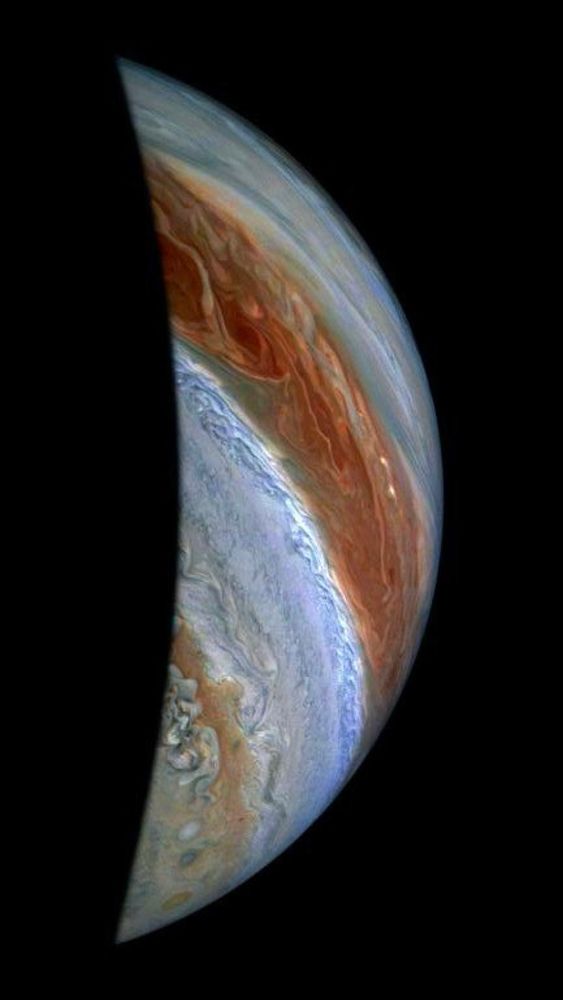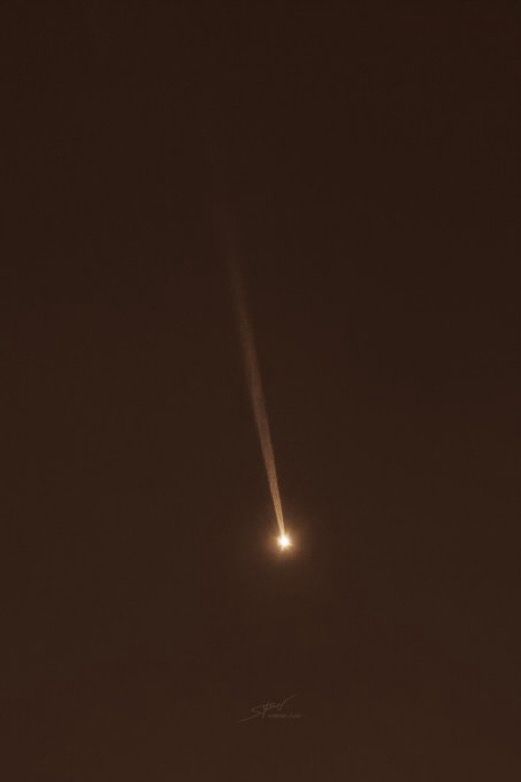
An incredible image of C/2025 A6 (Lemmon) by Tobias Swaczyna.
Enjoy it‼️
@xavi-bros.bsky.social
Amateur Astronomer. Anysllum Observatory owner. AstroSabadell member. Psychologist pursuing a Psychiatry Phd. Author of “En las playas de Sedna”.

An incredible image of C/2025 A6 (Lemmon) by Tobias Swaczyna.
Enjoy it‼️

The most difficult exoplanet transit I could observe until now:
K2-285c, a neptune-like around a K star 500 lightyears far.
Detected a tiny disminution of brightness of only 2,3 thousandths of a magnitude‼️The light curve is not beautiful but it’s a challenge achieved.

M52 is a rich open cluster with a mass of about 1200 suns. As usual in open clusters is very “young” (age 158 million years…).
Image taken from the amateur observatory Anysllum @AstroSabadell with a 35cm telescope and 45min exp in each RGB filter.

See this amazing Venus image done by NASA's Parker Solar Probe in its trip to the Sun in 2021.
It is possible to see some Venus details through its clouds‼️

How is our Galaxy’s shape?
The MilkyWay is a barred spiral galaxy with about 200000-400000 million stars… our sun is 30000 lightyears from the center where is a black hole.
Sun's Galactic rotation period is about 240 M years!
Image: Illustration by R.Hurt, JPL-Caltech, NASA

A moon over the sky of Mars:
In this Martian skyscape the brightest object is Deimos, the smallest of Mars’ two moons.
This image was taken before sunrise by Perseverance rover on March 1, 2025.
Image: NASA via APOD.

Communication with alien life:
Very different cognition, culture and language could be as difficult or more than technology or distance to communicate with them.
Image: movie The Arrival

The exoplanet Kepler-76b is situated 2684 lightyears far. Its a hot jupiter (mass of 2 Jupiters).
This transit observation was done from the Teide observatory, telescope IAC 80, by the IAC-AstroSabadell team‼️

The Messier 11 open cluster (“the wild duck”), is a compact, metal rich cluster situated 6120 lightyears far.
A beautiful contrast of its young stars with the more diverse stars of the rich Milky Way backgroud:
Image from the Anysllum Observatory, 90 minutes of RGB exposure.

Neptune, it’s wonderful rings and the main moon of this system, Triton, in a memorable image by the James Web Space Telescope… beautiful ‼️
08.10.2025 03:24 — 👍 3 🔁 0 💬 0 📌 0
Isaac Asimov:
“Don't you believe in flying saucers? in telepathy? in life after death?
No, I reply. No and no.
I believe in evidence, in observation confirmed by independent observers. I'll believe anything, no matter how wild and ridiculous, if there is evidence for it.”

Observed 16 exoplanet transits from the Anysllum Observatory:
Last one was XO-7 b: a gas giant exoplanet that orbits an F-type star. Its mass is 0.709 Jupiters.
Its star is situated 764 lightyears far‼️
During the transit the star is only 0.01 magnitudes fainter‼️

The galaxy cluster of Coma Berenice, Abell 1656, is situated 320 million lightyears far… and has about 1000 galaxies‼️
How many do you see in this image behind the blue bright stars of our own galaxy?
18 hours of LRGB exposure from the Anysllum Observatory, AstroSabadell.

The universe is expanding at different rates‼️
According a research using JWST data: the Hubble constant could be different when we observe in different directions:
www.livescience.com/space/cosmol...

When bright & dark nebulae met with open clusters, we see huge views: Melotte 15 -part of Heart Nebula- with bright stars between gas & dust!
Anysllum observatory image obtained after 21 hours of SHO-LRGB by Xavier Bros & Jaume Zapata both members of AstroSabadell.

GEORGE ORWELL:
“Who controls the past controls the future. Who controls the present controls the past.”
“In a time of deceit telling the truth is a revolutionary act.”
“The past was erased, the erasure was forgotten, the lie became the truth.”


Today, 48 years ago, Voyager 1 was launched to study Jupiter and Saturn. Today, Voyager 1 is about 25000 million km from Earth‼️
Images: NASA

The Sunflower Galaxy, M63, is a non-barred spiral galaxy, 29 million lightyears far.
See here many features in its spiral structure and its incredible dusty band.
10 hours LRGBH image by Jaume Zapata & Xavier Bros, Anysllum Observatory, AstroSabadell.
Procesed by Jaume Zapata.

Astronomers have observed one of the brightest fast radio bursts to date and pinpointed its origin to a star-forming region in a the spiral galaxy NGC 4142. These millisecond-long radio bursts originate from the highly magnetized remnants of massive stars.
Image:
D.Futselaar/MMT

WISPIT 2b: when an Exoplanet Carves a Gap in its Birth disk.
At the center lies a young Sun-like star. Surrounding the star is a bright, dusty protoplanetary disk where the new planet is clearing the way as it orbits the star.
Image: ESO, Richelle van Capelleveen via APOD web.


Quasar S50014+81 is one of the most luminous objects known in the universe: 3 trillion suns (25000 Milky Way’s combined light!). Its black hole devours 4000 sun masses/year: buff.ly/2Lrj5Nw.
Images: Right, illustration by NASA. Left, real image by Xavier Bros, Anysllum.


Jupiter moon Callisto has a subsurface frozen/liquid ocean as other bodies (Europa, Encelado...). The Callisto's one dissipates energy due to obliquity tides. This explains its orbital inclination & eccentricity according this 2020 study:
bit.ly/3mjduWQ
Images: NASA

This is a very young star not far from us, the Herbig-Haro 49/50, with a more distant spiral galaxy perfectly positioned at its tip behind the Herbig-Haro object.
Image by the James Webb Space Telescope‼️

This is an enhanced color image of Jupiter’s northern high latitudes during the Juno spacecraft 69th flyby. This image was taken from an altitude of 58,000 kilometers and was processed by the citizen scientist Jackie Branc.
29.07.2025 07:55 — 👍 12 🔁 3 💬 0 📌 0
The birth of a supermassive black hole?
This Infinity galaxy image by JWST shows two very compact, red nuclei, each surrounded by a ring: the collision of two disk galaxies. A young black hole is in between the two nuclei, within a vast expanse of gas: go.nasa.gov/4nQiwdo

The exoplanet Kepler-447b orbits a G type star similar to our sun. It’s a giant planet (about 165% of Jupiter) composed mainly of gas.
When it transits in front the star we see it only 0.004 magnitudes fainter!
This tiny gap has been detected from the Anysllum Observatory.
Wow‼️


This is not a comet!
Mercury has a 2.5 million km long tail.
The solar wind and micro-meteorites eject sodium atoms from Mercury’s surface. This creates a yellow-orange tail of sodium gas only visible with a 589nm filter and specially good conditions.
Images: S. Voltmer

What are the 25 brightest stars in our night sky?
See here them in true color with their IAU-recognized names.
Where is the famous Polaris? In fact is not between the 25 brightest stars‼️
These wonderful images were done by Tragoolchitr Jittasaiyapan via APOD website.


Very proud to announce the AstroSabadell team in the PRO-AM project to observe exoplanets has been awarded!
2024 EUROPLANET IBERIAN AMATEUR ASTRONOMY AWARD
in Solar System Astronomy and Exoplanets

A new third interstellar visitor -probably an asteroid- A11pl3Z has been discovered on July 1.
It has a high eccentric hyperbolic orbit (65km/sec speed) & size 20km. Its perihelion will be on October 29, 2025.
Image: E. Guido, M. Rocchetto, J. Ferguson TEL 0.35-m f/3.0 reflector + CMOS